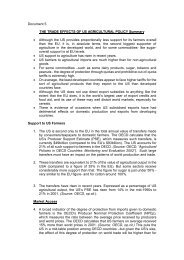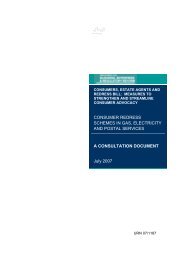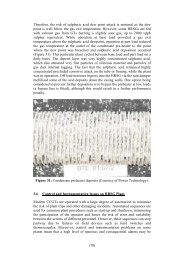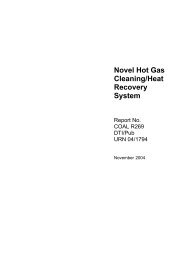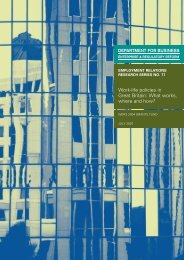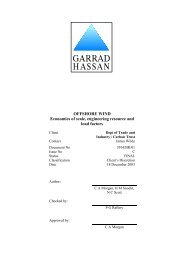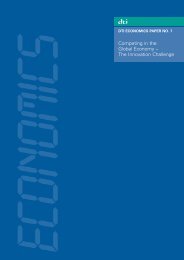Coal Fired Power Plant Operations - DTI Home Page
Coal Fired Power Plant Operations - DTI Home Page
Coal Fired Power Plant Operations - DTI Home Page
You also want an ePaper? Increase the reach of your titles
YUMPU automatically turns print PDFs into web optimized ePapers that Google loves.
3 INDIVIDUAL OPTIMISERS<br />
2 PT/03/BD1076/R Revision 2<br />
The following individual optimisers have been considered during this project:<br />
On-line thermal efficiency Package<br />
GNOCIS boiler optimiser<br />
GNOCIS steam side optmiser<br />
ESP Optimisation<br />
Intelligent Sootblowing System (ISBS)<br />
ESP refers to Electrostatic Precipitator that is used to remove particles from the air-flow before<br />
being released to the atmosphere up the stack. Pulverised coal is burnt in modern coal-fired<br />
plants and this can collect on the tube banks in the boiler. These tube banks are cleaned on-line<br />
by high-pressure jets of steam in an operation called sootblowing.<br />
These optimisers are briefly described below.<br />
4 ON-LINE THERMAL EFFICIENCY PACKAGE<br />
This package is a detailed on-line efficiency calculation for the power unit. The process being<br />
modelled is shown in Fig 4.1. The two fans, forced draft (FD fan) and induced draft ( ID fan) are<br />
shown on the left of the diagram. These large fans provide most of the air flow through the unit.<br />
Pulverised coal is added to the air in the mills and then burnt in the boiler. The combustion heat<br />
is used to produce steam in the superheaters and reheaters. The flue gases are released to the<br />
atmosphere up the stack after the ash particles have been removed from the flow in the ESP and<br />
heat has been recovered from the waste air by warming fresh incoming air.<br />
The main difficulty with providing a real time heat rate calculation is the accurate measurement<br />
of both the amount of coal and its heat content entering the boiler. The calculation procedure is<br />
shown in Fig 4.2 and it starts with a detailed (ultimate) coal analysis that is generally not<br />
available in real time. Substantial work has been done by EPRI in the past on a real time heat<br />
rate calculation, see Gadiraju et al 1989, however all this previous work assumed the ultimate<br />
coal analysis is available. A more recent EPRI study, see Munukutla et al 1995 suggested that<br />
the coal composition can be determined from an on-line analysis of the flue gas composition.<br />
This work was done on a test combustor at the Southern Research Institute Birmingham<br />
Alabama. Since all values are available in real time, the heat content of the coal can be<br />
calculated in real time. The revised calculation process for the on-line method is shown in Fig<br />
4.3.<br />
The on-line heat rate calculation was compared to the original method during 4 days of testing,<br />
4-7 th October 2000 at <strong>Plant</strong> Hammond. There was good agreement between the on-line coal<br />
analysis and the ultimate analysis as shown in Fig 4.4.<br />
The heat exchangers between incoming and out-going air involve leakage of the incoming air<br />
into the flue gas. This leakage can be determined by measuring the gas composition before and<br />
after the heat exchanger.



